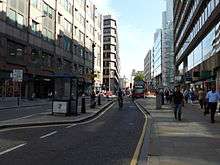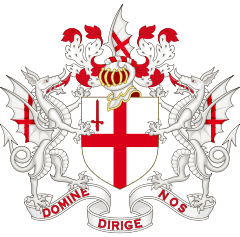Ring of steel (London)

The ring of steel is the popular name for the security and surveillance cordon consisting of road barriers, checkpoints and several hundred CCTV cameras surrounding the City of London, the financial district at the heart of Greater London. The measures were installed in the 1990s to deter terrorism and other threats.[1][2]
Number of cameras
According to a 2011 Freedom of Information Act request, the total number of local government operated CCTV cameras in the City of London was 649.[3]
The number of surveillance cameras that are part of the ring of steel is often wrongly quoted as 500,000.[4] This figure relates to Greater London, which has an area of 1,572 square km compared with the 3 square km of the City of London that the ring of steel covers. Furthermore, it has been acknowledged for several years that the methodology behind this figure is flawed,[5] but it has been widely quoted.[6]
The figure of 500,000 comes from a study by Michael McCahill and Clive Norris of UrbanEye published in 2002.[7] Based on a small sample in Putney High Street, McCahill and Norris extrapolate the number of surveillance cameras in Greater London to be 500,000 and in the United Kingdom to be 4.2 million. More reliable estimates put the total number of private and local government surveillance cameras in the whole of the United Kingdom at around 1.85 million in 2011.[8][9]
Recent use
Following the September 11 attacks in the United States in 2001, and a reported increased terrorist threat to the United Kingdom, security was stepped up with occasional spot checks on vehicles entering the cordon, although not to previous levels.[2] In December 2003, the ring of steel was widened to include more businesses in the City.[2] This was as a direct result of a police report that categorised a terrorist attack on the City as "inevitable". Traffic entering the City is also monitored and recorded at the boundary of the London congestion charging zone, which covers a wider area.
History and purpose
The measures were introduced by Owen Kelly, then the City of London Police commissioner, following the Provisional IRA bombing campaign in London in the 1980s and early 1990s including attacks within the City such as the 1992 Baltic Exchange and 1993 Bishopsgate attacks.[2]
The term was borrowed from an earlier stage of the Troubles when the centre of Belfast was fortified against attacks; this fortified perimeter was known as the "ring of steel".[10]
Roads entering the City were narrowed and small chicanes were created to force drivers to slow down and be recorded by CCTV cameras. These roads typically had a concrete median with a sentry box where police could stand guard and monitor traffic.[2] City planners call these types of precautions "fortress urbanism".[11] Some roads were closed to traffic entirely.[12] Despite the term "ring of steel", the roadblocks and chicanes were actually created with concrete blocks,[11] sometimes plastic coated, that were wedged together.
Initially the sentry posts were staffed by armed police almost continuously. The ring of steel consisted of plastic cones and on-duty police officers which the locals described as the "ring of plastic".[13] It served the purpose of providing a visible sign to the public that the City authorities were taking the threats of more attacks by the IRA seriously.[13] This was replaced by more permanent structures consisting of concrete barriers, checkpoints and hundreds of video cameras.[11] Following IRA ceasefires the police presence was curtailed.
Attacks outside the ring
In 1996, the IRA attacked another area of central London by exploding a bomb at the Docklands, resulting in two deaths, 39 other casualties and £85 million worth of damage. The attack showed that while the ring of steel was able to hinder attacks inside the City itself, terrorists could instead target other high-value areas such as the Docklands or Westminster.
See also
- Lower Manhattan Security Initiative
- Mass surveillance in the United Kingdom
- Police-enforced ANPR in the UK
References
- ↑ City of London Police. "3.2.4 The automated number plate recognition (ANPR) system and the Corporation of London’s traffic and environment zone culminate in what is generally referred to and known as the ‘ring of steel’.
- 1 2 3 4 5 BBC News (2003-12-08)
- ↑ "The Price of Privacy: How local authorities spent £515m on CCTV in four years" (PDF). Big Brother Watch. February 2012. p. 21. Retrieved 4 February 2015.
- ↑ See, for example, "Expand New York City's surveillance camera network", Daily News, 16 February 2015, retrieved 21 May 2015; "Police Go Live Monitoring D.C. Crime Cameras", The Washington Post, 11 February 2008, retrieved 21 May 2015; eds, Giorgio Franceschetti ; Marina Grossi, (2011), Homeland security threats, countermeasures, and privacy issues, Boston, Mass.[u.a.]: Artech House, p. 137, ISBN 9781608071067, retrieved 21 May 2015; Luppicini, [edited by] Rocci (2012), Ethical impact of technological advancements and applications in society, Hershey, PA: Information Science Reference, p. 83, ISBN 9781466617742, retrieved 21 May 2015
- ↑ "FactCheck: how many CCTV cameras?". Channel 4 News. 18 June 2008. Retrieved 8 May 2009.
- ↑ See, for example, "Bloomberg reviews London's 'ring of steel'". Associated Press. 11 May 2010. Retrieved 21 May 2015.
- ↑ "CCTV in London" (PDF). Retrieved 22 July 2009.
- ↑ "How many cameras in the UK? Only 1.85 million, claims ACPO lead on CCTV". SecurityNewsDesk. 1 March 2011. Retrieved 2 March 2011.
- ↑ "How many cameras are there?". CCTV User Group. 18 June 2008. Retrieved 8 May 2009.
- ↑ Coaffee (2004), p. 201 (pdf p. 2) first paragraph.
- 1 2 3 Lipton (2005-07-24)
- ↑ Coaffee, Jon (2003) p.176
- 1 2 Coaffee (2004), p.204 (pdf p. 5) second paragraph
External links
- Buckley, Cara (2007-07-09). "New York Plans Surveillance Veil for Downtown". New York Times. p. 1. Retrieved 2008-04-10.
- BBC News (2003-12-08). "'Ring of steel' widened". BBC News Online. Retrieved 2008-04-10.
- City of London Police, Counter-Terrorism, January 2005
- Coaffee, Jon (2003), Terrorism, Risk, and the City: The Making of a Contemporary Urban, Ashgate Publishing, Ltd., ISBN 0-7546-3555-4, ISBN 978-0-7546-3555-0.
- Coaffee, Jon (2004). Rings of Steel, Rings of Concrete and Rings of Confidence: Designing out Terrorism in Central London pre and post September 11, International Journal of Urban and Regional Research, Vol 28 Number 1 2004.
- Lipton, Eric (2005-07-24). To Fight Terror, New York Tries London's 'Ring of Steel', New York Times, 24 July 2005
